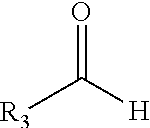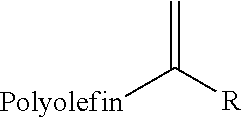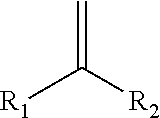Carbonyl-ene functionalized polyolefins
a functionalized polyolefin and carbonyl ene technology, applied in the direction of physical/chemical process catalysts, chemical/physical processes, catalysts, etc., can solve the problems of saturated compounds of prior art polyisobutyl alcohols, and require expensive processing equipmen
- Summary
- Abstract
- Description
- Claims
- Application Information
AI Technical Summary
Benefits of technology
Problems solved by technology
Method used
Image
Examples
example 1
Preparation of ω-Hydroxymethylpolyisobutylene with Dimethylaluminum Chloride
[0084]
[0085]To a flask equipped with a magnetic stirrer and nitrogen inlet was added 5 grams of polyisobutylene (molecular weight 1000, 80% methylvinylidene), 136.5 milligrams of paraformaldehyde and 15 milliliters of anhydrous methylene chloride. Dimethylaluminum chloride (6.8 milliliters of a 1M solution in hexanes) was added via syringe in one portion. The reaction solution was then stirred for 16 hours at room temperature. The reaction was cooled in an ice bath and 15 milliliters of a 1% hydrochloric acid solution was added drop-wise. The resulting biphasic solution was extracted (3×15 milliliters) with hexanes. The combined organic layers were dried over magnesium sulfate, filtered and the solvent removed under vacuum to yield the crude product. The crude reaction product was purified by chromatography on silica gel eluting with hexane, followed by 10% ethyl acetate in hexane to yield 3.85 grams of the ...
example 2
Preparation of ω-4-Nitrophenylhydroxymethylpolyisobutylene with Dimethylaluminum Chloride
[0086]
[0087]To a flask equipped with a magnetic stirrer and nitrogen inlet was added 5.35 grams of polyisobutylene (molecular weight 1000, 80% methylvinylidene), 0.74 grams of 4-nitrobenzaldehyde and 15 milliliters of anhydrous methylene chloride. Dimethylaluminum chloride (6.8 milliliters of a 1M solution in hexanes) was added via syringe in one portion. The reaction solution was then stirred for 16 hours at room temperature. The reaction was cooled in an ice bath and 15 milliliters of a 1% hydrochloric acid solution was added drop-wise. The resulting biphasic solution was extracted (3×15 milliliters) with hexanes. The combined organic layers were dried over magnesium sulfate, filtered and the solvent removed under vacuum to yield the crude product. The crude reaction product was purified by chromatography on silica gel eluting with hexane, followed by 10% ethyl acetate in hexane to yield 4.3 g...
example 3
Preparation of ω-Hydroxymethylpolyisobutylene with Boron Trifluoride Etherate
[0088]To a flask equipped with a magnetic stirrer and nitrogen inlet was added 20 grams of polyisobutylene (molecular weight 1000, 80% methylvinylidene), 0.6 grams of paraformaldehyde and 60 milliliters of anhydrous methylene chloride. Boron trifluoride etherate (0.123 milliliters) was added via syringe in one portion. The reaction mixture was stirred for 16 hours at room temperature. The mixture was diluted with 40 milliliters of methylene chloride followed by 2 milliliters of a saturated aqueous ammonium hydroxide solution. A precipitate was filtered out. The solution was washed with saturated sodium bicarbonate followed by saturated sodium chloride solution. The methylene chloride layer was dried with anhydrous magnesium sulfate. The solvent was removed under vacuum to yield the crude product. The crude reaction product was purified by chromatography on silica gel eluting with hexane, followed by 10% eth...
PUM
| Property | Measurement | Unit |
|---|---|---|
| temperature | aaaaa | aaaaa |
| polydispersity | aaaaa | aaaaa |
| polydispersity | aaaaa | aaaaa |
Abstract
Description
Claims
Application Information
 Login to View More
Login to View More - R&D
- Intellectual Property
- Life Sciences
- Materials
- Tech Scout
- Unparalleled Data Quality
- Higher Quality Content
- 60% Fewer Hallucinations
Browse by: Latest US Patents, China's latest patents, Technical Efficacy Thesaurus, Application Domain, Technology Topic, Popular Technical Reports.
© 2025 PatSnap. All rights reserved.Legal|Privacy policy|Modern Slavery Act Transparency Statement|Sitemap|About US| Contact US: help@patsnap.com



